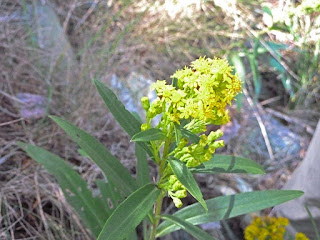About a week and a half ago I drove down to the Coastal Maine Botanical Gardens in Boothbay Harbor for a class on wild beach plants. It was well worth the drive! Our teacher was Melissa Cullina, formerly of the New England Wildflower Society in Massachusetts, who not only showed us how to identify the plants, but told us about their cultural histories, reading us poetry, excerpts from colonial diaries, and talking about the various botanists who came from Maine as if they were personal relatives. It was charming and enlightening, and the time went quickly. We spent four hours in two very different habitats - the first was a marshy wooded shoreline and the second was a rocky headland. The sun was intense and straight overhead, so the photos I took during the class are so overexposed or flat that they are barely even educational, so I'm not including many.
Here are my favorite tidbits from the class:
1. Rushes are Round and Sedges have Edges. (That's very helpful, you should remember that, too.)
2. Plantago maritima - a plant I see all the time. I finally know its name! If you've ever been introduced to someone at a party who previously you had seen around town but not known, it is a similar feeling. Ah, so that's who you are! Early sailors in this area used this as a salad green. One of my classmates tasted it and said it was salty. No surprise there.
3. Seaside Goldenrod (Solidago maritima) - note that the leaves have smooth edges, while most (non-seaside) goldenrod have toothy leaves. I see this one everywhere, too. They are blooming now, and look very picturesque clinging to the rocks by the ocean.
4. The Plants of Acadia National Park is an incredibly useful book, with much better pictures than the ones I snapped on the run. It covers all the plants we discussed during this class, and I plan to order it and take it down to the shore for a class review.
5. There are a variety of ways that plants cope with a saltwater environment. Some salt-tolerant plants keep the high salt concentration from interfering with respiration by storing it in their protoplasm, which keeps the water flowing through membranes. Succulent plants store lots of fluid which dilutes the salt concentrations. And still other plants drop their leaves when the salt in them gets too concentrated. Some native grasses, like Spartina, actually exude the salt through special glands.
If you live north of Boston and haven't been to the Botanical Garden yet, make a point of it. It was a bit of a drive for me (three hours) but then, living where I do just about everything is a long drive. I'll leave you with one last photo from the gardens:





No comments:
Post a Comment